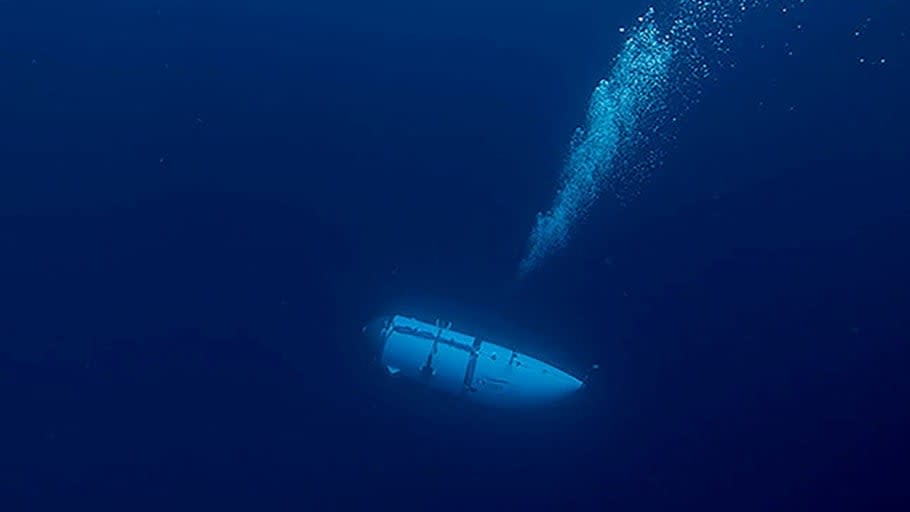More ‘Banging Noises’ Heard at Titanic Sub Search Site

Rescue crews searching for the submersible that vanished during a trip to the Titanic wreck heard more underwater “banging noises” on Wednesday, according to authorities—who conceded they still have no idea what the sounds are.
A Canadian P-3 flight crew first picked up the sounds on Tuesday, and heard them again Wednesday morning, U.S. Coast Guard spokesman Capt. Jamie Frederick said at a press conference on Wednesday afternoon. But he and Carl Hartsfield, an expert in subsea acoustics from the Woods Hole Oceanographic Institute, cautioned against reading too much into it.
“The ocean is a very complex place,” Hartsfield said. “Obviously, [there are] human sounds, nature sounds, and it’s very difficult to discern what the source of those noises are, at times. But I can tell you that this team has multiple sensors, they’re in the area, they’re sending data back expeditiously to the best in the world, people to analyze that data, and then they’re feeding the results of that analysis back to the unified team and they’re making decisions.”
Hartsfield, who joined the search in an advisory role, said those decisions are being made “based on data,” and that “nothing is being ruled out.”
“I can tell you from my experience with acoustics that there are sounds by biologics that sound manmade to the untrained ear,” he said. “But I can assure you that the people listening to these tapes are trained. There are a lot of vessels in the area and they each make noise. So all of that has to be eliminated.”
Red Flags: Titanic Sub Company Was Warned About Safety
The group of five passengers went missing Sunday on a $250,000-a-head tourist voyage to the wreck, located 400 miles off Newfoundland. Frederick said the search area had expanded to twice the size of Connecticut, and that further reinforcements were arriving. An expert submariner from the British Royal Navy is on hand to assist, and a team of “highly trained French ROV [remotely-operated vehicle] operators,” who are bringing with them crucial underwater drones, departed St. John’s, Newfoundland on Tuesday night and are en route, according to Frederick.
The initial announcement on Tuesday night that potential signs of life had been heard gave rescuers new hope, even as it remains unclear what happened to the submersible—or where exactly it is.
Underwater drones were initially redirected “in an attempt to explore the origin of the noises,” the Coast Guard said late Tuesday. Those searches “yielded negative results but continue,” and the data from the aircraft will be used to plot future searches.
An email sent to Department of Homeland Security leadership said the Canadian aircraft deployed “sonobuoys” that “heard banging sounds in the area every 30 minutes,” according to Rolling Stone. “Four hours later additional sonar was deployed and banging was still heard,” the email continued.
A subsequent update sent to the group of DHS leaders Tuesday night said that more audible sounds were heard in the area—though they appeared different from the first set of noises, according to CNN.
Meanwhile a white, rectangular object was discovered floating in the water by another Canadian aircraft but Frederick clarified on Wednesday that the item was unrelated to the search.
The Lost Titanic Sub Didn’t Even Have a Basic Safety Beacon
Rear Adm John Mauger, the Coast Guard official leading the search, told CBS News that the banging noise could have been caused by a range of things. “You have to remember that it’s the wreck site of the Titanic so there is a lot of metal and different objects in the water around the site,” he said.
The search for the privately owned and operated sub is a race against time because it had just 96 hours worth of oxygen onboard when it went missing Sunday morning.
The Explorers’ Club, a group connected to Hamish Harding—a British billionaire said to be on board the vessel—said Tuesday night that news of banging sounds had given members “much greater confidence” that recovery efforts may still be possible.
“There is cause for hope, based on data from the field—we understand that likely signs of life have been detected at the site,” the group said in a statement.
The four others on board were identified earlier in the day as Shahzada Dawood and his 19-year-old son, Suleman, both from one of the richest families in Pakistan; Paul-Henri Nargeolet, a French diver with 37 expeditions to the Titanic wreckage under his belt; and Stockton Rush, the CEO and founder of OceanGate Inc., the company behind the vessel.
On Tuesday night, RMS Titanic President Jessica Sanders said in a statement that Nargeolet’s knowledge of the wreck site “is unparalleled” and that “we trust and have faith his experience will help navigate this critical situation.” Sanders added “no one has a better chance of navigating through equipment failures than he does. We remain hopeful.”
— RMS Titanic, Inc. (@RMSTitanic_Inc) June 21, 2023
While recovery efforts are ongoing, OceanGate Expeditions is under increasing scrutiny after reports emerged of the company’s “risky” approach and shoddy safety record.
Lawsuits filed by former employees and even several letters from experts in the industry show concern in recent years for the safety of OceanGate’s Titan vessel—the same one now missing.
“The submersible industry had significant concerns over the strategy of building a deep sea expedition submersible without following existing classification safety guidelines,” Will Kohnen, the chairman of the Manned Underwater Vehicles committee of the Marine Technology Society, told The New York Times on Tuesday of the company’s record.
The largely unregulated craft was also not outfitted with any emergency location transmitter (ELT)—a common safety feature on board most air and watercraft in case of emergencies.
Get the Daily Beast's biggest scoops and scandals delivered right to your inbox. Sign up now.
Stay informed and gain unlimited access to the Daily Beast's unmatched reporting. Subscribe now.

